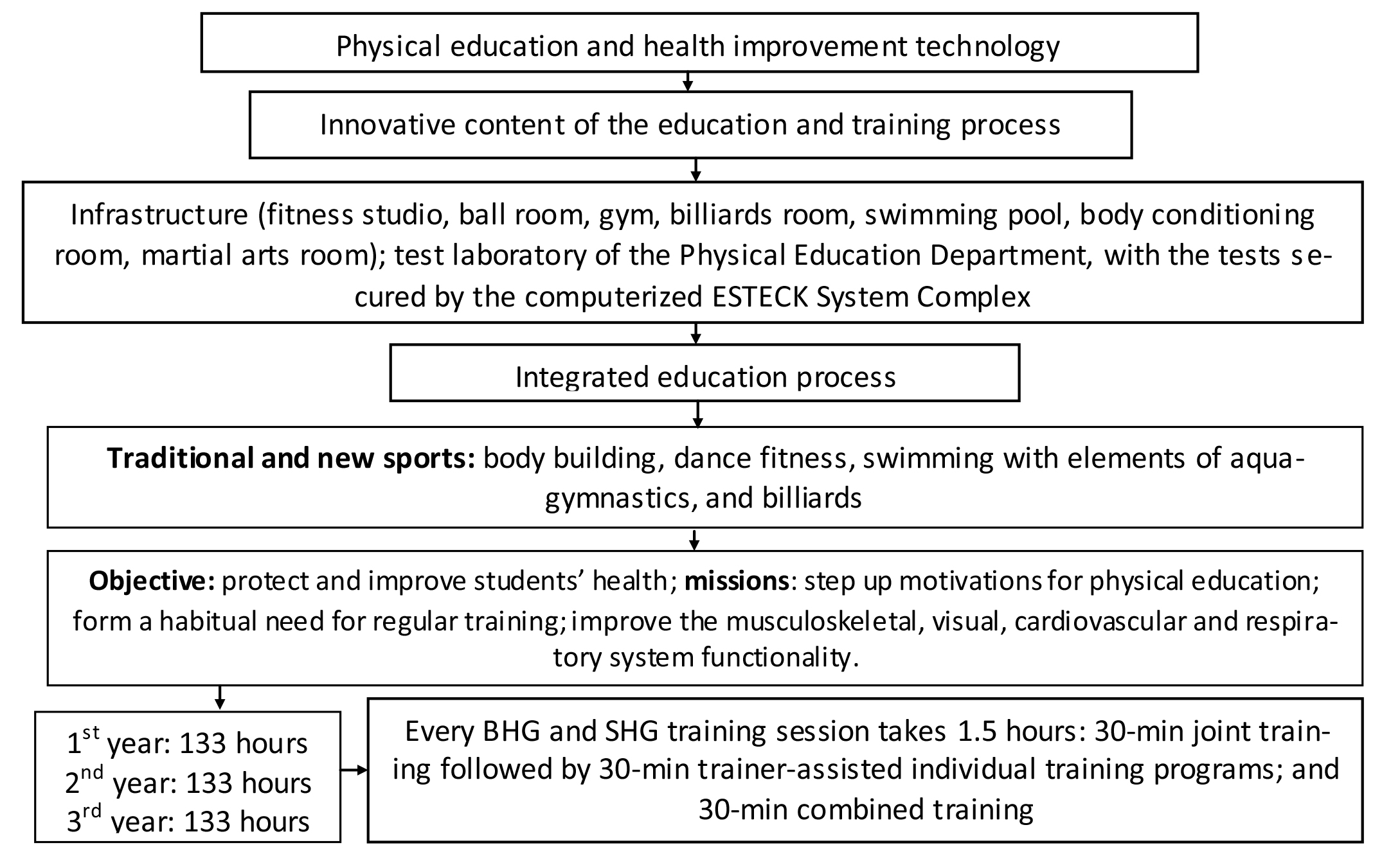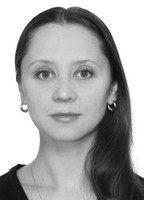Physical education in special health group based on recreational gymnastics and billiards
Фотографии:
ˑ:
O.V. Mamonova1
Dr.Hab., Professor S.I. Filimonova2
PhD, Associate Professor L.M. Stolyar3
R.Y. Bulychev1
1Plekhanov Russian University of Economics, Moscow
2Moscow City Pedagogical University, Moscow
3Moscow State Pedagogical University, Moscow
Keywords: students, recreational gymnastics, billiards.
Background. Presently the academic physical education system is in need of reforms to redesign its key components, content, values, technologies and duly differentiate the curricula for the basic (BHG), preparatory and special (SHG) health groups. It is high time for the reform since about 60% of the national student population is tested with health disorders dominated by cardiovascular (30-60%), musculoskeletal (25-40%) and ophthalmological diseases (13-25%); with 40-45% of the student population being attributed to SHG [2, 4, 5, 8]. O.G. Rumba and V.L. Kondakova in their study report offered the physical education and health improvement technology design mechanisms and a system of the academic physical activity control and management. J.V. Muravyova in her work offered a special health recreation and improvement technology; and L.A. Bartnovskaya in her thesis developed an applied health technology. The physical education and health improvement technology of our own design includes elements of dance fitness; swimming with aqua-gymnastics exercises; body building and billiards. The technology may be applied to improve the design and content of the traditional education process; redesign the methods, models and tools for compensation of the physical inactivity of the SHG students; and ensure their progress in physical qualities and health standards.
Objective of the study was to provide theoretical and practical grounds for the physical education and health improvement technology based on recreational types of gymnastics and billiards in application to academic special health groups (SHG).
Methods and structure of the study. The study was performed at Plekhanov Russian University of Economics. Subject to the study were 146 first-to-third-year (2016-17) students including 74 people in the Study Group (composed of the special health group students) and 72 people in the Reference Group (basic health group): see Figure 1, Tables 1 and 2.

Figure 1. Physical education technology for the first-to-third year SHG students
Dancing exercises (Tables 1 and 2) is the technology component designed to improve the blood circulation in the cardiac muscle, metabolism, recreational processes in the myocardium, movement coordination and culture and emotional component. Body building exercises are designed to train the extra-cardiac blood circulation, improve the blood outflow from veins to the right auricle of the heart and increase pressure in the abdominal cavity thereby reducing the stagnant conditions in the internal organs. Billiards is another key component of the proposed technology designed to train forearm, hand, leg, back, head and pelvis muscles since they are critical for the cueing, bridging and potting techniques: see Table 1.
Table 1. Time distribution in the SHG physical education technology
|
|
Education program section |
Academic year |
|||
|
1 |
2 |
3 |
Total |
||
|
1 |
Theoretical section |
4 |
4 |
4 |
12 |
|
2 |
Body building |
32 |
32 |
31 |
95 |
|
|
Billiards |
32 |
31 |
32 |
95 |
|
|
Swimming with elements of aqua-gymnastics |
31 |
32 |
32 |
95 |
|
|
Dance fitness |
32 |
32 |
32 |
96 |
|
3 |
Progress test section |
2 |
2 |
2 |
6 |
|
|
Total time |
133 |
133 |
133 |
400 |
Table 2. SHG physical education technology components
|
Body building |
|
Provides the means to improve health, develop physical qualities and build body; includes gymnastic exercises with weights: medballs, kettlebells, hemispheres, bodybars; exercises on cardio-training simulators to correct postural disorders and train underdeveloped muscle groups; improve strength abilities, flexibility, endurance (by low-intensity cardio-exercises); improve wellbeing, activity and mood [6]. |
|
Dance fitness |
|
This fitness component is highly emotional, and helps build up the movement culture; it is highly effective in the health improvement aspect. Gymnastics and dancing to music include a variety of physical exercises with/ without apparatuses (fitball, gymnastic stick, ball) to facilitate decompression of the vertebral structures, enforce the muscular corset, improve suppleness, tendons, develop muscular strength, flexibility, endurance and movement coordination; secure progress in mental and physiological statuses, wellbeing etc. |
|
Swimming with elements of aqua-gymnastics |
|
This fitness component provides good means for body tempering and conditioning by low temperatures, improve tolerance to catarrhal diseases and other environmental impacts. The aqua-gymnastics elements are designed for rehabilitation and recreation and provide the unique means for health correction, improvement and physical progress, with particular benefits in development of physical qualities including endurance, strength, speed, suppleness and movement coordination. Due postural control, high harmony of movements and horizontal postures unload the spine, help correct postural disorders etc. |
|
Billiards |
|
The fitness component is designed for active recreation being free of high functional loads, so it effectively improves mental and physiological statuses, wellbeing, activity and mood; develops visual motor responses and inter-muscular coordination ability; expands by 10÷18% the effective vision fields of both eyes; develops coordination, accuracy and motor responses, forearm and hand speed, dexterity, visual control and distance judging; and it is also highly effective for activation of the conditional excitation processes in the cerebrum [1, 3]. |
Study results and discussion. Combined tests of the subjects’ physical progress included subjective monitoring tests and the following tests using the computerised ESTECK System Complex (Multiscan PROTM): bioimpedansometry, digital pulse wave test and digital HR variation test: see Table 3.
Table 3. Students’ functionality test rates
|
Test rates |
Male |
Female |
||
|
BHG |
SHG |
BHG |
SHG |
|
|
n |
21 |
11 |
18 |
33 |
|
Body composition rates |
||||
|
Body mass index, conv. units |
21,78 ±5,1 |
21,92±2,2 |
20,1±1,7 |
21,32±2,6 |
|
Lean body mass, % |
58,9 ±5,1 |
60,22±4,6 |
42,7 ± 4,6 |
43,1±4,8 |
|
Total water, % |
59,3±2,7 |
60,5±3,1 |
56,2±1,9 |
53,3±6,3 |
|
Blood pressure rates |
||||
|
Systolic pressure, mmHg |
126,6±11,9 |
124,8±11,5 |
116,6±13,3 |
118,1±10,8 |
|
Diastolic pressure, mmHg |
75,6±9,9 |
80,2±15,8 |
73,3±9,9 |
80,39±11,7 |
|
Peripheral vascular resistance, PVR, Pa·s/m3 |
||||
|
PVR, Pa·s/m3 |
1224,4±125,6 |
1240,5±300,6 |
1400,5±150,8 |
1463,6±255,1 |
|
Cardiac discharge (CD), l/min |
6,2±0,7 |
6,3±1,1 |
5,02±0,6 |
5,2±0,7 |
|
Arterial rigidity, m/s |
6,3±0,4 |
6,3±0,4 |
5,9±0,3 |
6,1±0,4 |
|
Blood oxygen saturation, SpO2, % |
||||
|
SpO2, % |
97,5±0,8 |
97,1±0,7 |
97,6±1,1 |
96,3±5,4 |
|
Oxygen consumption disorders in the microcirculation system, VO2 |
||||
|
VO2 |
322,1±8,1 |
308±45,4 |
311,3±33,4 |
320,9±5,7 |
|
Heart rate variability |
||||
|
HR, bpm |
84,7±16,8 |
83,6±24,9 |
83,8±12,93 |
90,8±22,8 |
|
Stress rate, conv. units |
137,5 ±80,4 |
182,4±174,2 |
137,91±86,8 |
188,6±135,3 |
|
Cardiac discharge (CD), l/min |
6,2±0,7 |
6,3±1,1 |
5,02±0,6 |
5,2±0,7 |
|
Sympathetic/ parasympathetic system balance, NC/ VC |
||||
|
Standard deviation, SDNN |
50,8±18,2 |
50,4±23,9 |
48±13,8 |
43,8±13,8 |
|
NC/ VC |
1,4±0,7 |
1,4±0,9 |
1,3±0,6 |
1,7±1,2 |
Note: ![]() mean arithmetic value, σ mean square deviation; significant difference (р>0.05)
mean arithmetic value, σ mean square deviation; significant difference (р>0.05)
The HR variability at rest (Table 3) was the following: HR was tested to vary within the physiological standard; the sympathetic/ parasympathetic system balance (NC/ VC) was tested at 1.5 conventional units (0.5-2.0 conv. units); stress index was tested at 137 and 185 conventional units in the male and female subjects, respectively (with 50-200 conv. units rated normal). The body mass index was found normal (20.1 to 21.9 conv. units); lean body mass was tested lower than the standard (ranging from 42.7 to 60.2%); and the total water was found normal (53.3 to 60.5%). The oxygen metabolism was tested to vary across the sample from the standard, with the blood oxygen saturation up to 97% with very high oxygen consumption disorders in the microcirculation system (315 units); the peripheral vascular resistance was tested at 1331.65 , Pa·s/m3 (900.0 – 1500.0, Pa·s/m3); the cardiac discharge was found to vary from 5.0 to 6.3 l/min (normal); the vascular rigidity was tested low at 6.2 m/s (versus the norm of 7-9 m/s); the average systolic and diastolic blood pressure rates (SAP/ DAP) were tested at 116.6 to 126.6 mmHg and 80.3 to 73.3 mmHg, respectively.
Conclusion. The computerised test data provided by ESTECK System Complex (Multiscan PROTM) were used to customise the physical education process to the diagnosed health disorders and clinical indications based on the objectively rated individual adaptive capabilities, duly identified risks of failures and early manifestations of potential health disorders including stress response rates.
References
- Vishnevskiy V.A. Vliyanie akademicheskikh zanyatiy bilyardom na sostoyanie studentov spetsialnykh meditsinskikh grupp [Effects of academic billiards mastering course on special health group students]. Teoriya i praktika fiz. kultury, 2017, no. 1, pp. 86-88.
- Kondakov V.L. Sistemnye mekhanizmy konstruirovaniya fizkulturno-ozdorovitelnykh tekhnologiy v obrazovatelnom prostranstve sovremennogo vuza. Avtoref. dis. dokt. ped. nauk [System mechanisms of physical culture and health technology design in modern university educational space. Doctoral diss. abstract (Hab.)]. St. Petersburg, 2013, 50 p.
- Kondrakov G.B., Andryushchenko L.B., Yablochkina I.V., Podoruev Yu.V. Kontseptsiya formirovaniya rekreatsionnoy fizicheskoy kultury v ekonomicheskom vuze [Recreational physical culture formation concept for economics university]. Teoriya i praktika fiz. kultury, 2016, no. 9, pp. 22-24.
- Mamonova O.V. Bilyard v korrektsii psikhofizicheskogo sostoyaniya studentov-ekonomistov [Billiards to correct psychophysical condition of economics students]. Teoriya i praktika fiz. kultury, 2016, no. 4, P. 17.
- Rumba O.G. Sistema pedagogicheskogo regulirovaniya dvigatelnoy aktivnosti studentov spetsialnykh meditsinskikh grupp. Dis. dokt. ped. nauk [System of pedagogical control of special health group students' motor activity. Doctoral diss. (Hab.)]. St. Petersburg, 2012, 472 p.
- Filimonova S.I., Minaev A.V. Fizicheskaya kultura kak uchebnaya distsiplina v sovremennoy sotsiokulturnoy situatsii [Physical education as academic discipline in modern socio-cultural situation]. Kultura fizicheskaya i zdorovye, Voronezh, no. 8 (40), 2012, pp. 15-20.
- Shutova T.N., Kuz'min M.A., Kondrakov G.B., Mamonova O.V. Model integratsii traditsionnykh vidov sporta i fitnesa v fizicheskom vospitanii studentov [Traditional sports and fitness integration model for academic physical education]. Teoriya i praktika fiz. kultury, 2016, no. 9, pp. 19-21.
- Shutova T.N., Andryushchenko L.B. Fitnes-tekhnologii dlya povysheniya dvigatelnoy aktivnosti molodezhi na osnove globalnogo podkhoda [Young people's motor activity encouraging fitness technologies based on global approach]. Teoriya i praktika fiz. kultury, 2017, no. 3, pp. 54-56.
- Shutova T.N., Vezenitsyn O.V., Vyprikov D.V. Atleticheskaya gimnastika v fizicheskom vospitanii studentov. Ucheb. posobie [Body-building in academic physical education. Study guide]. Moscow, 2016, 108 p.
Corresponding author: mamonova-o-v@mail.ru
Abstract
The article presents a physical education and health improvement technology based on recreational gymnastics and billiards in application to physical education of special health groups (SHG). The study was performed at Plekhanov Russian University of Economics. Subject to the study were 146 first-to-third-year students including 74 people in the Study Group (composed of the special health group students) and 72 people in the Reference Group (basic health group).
The authors have developed a physical education technology customizable for different nosological groups to offer the most efficient combinations of the recreational gymnastics and billiards practices in the first-to-third-year curricula; special education courses for each academic year; test exercises and standards for the SHG students; and a health monitoring system with express-tests using the ESTECK System Complex. It should be noted that it was the first time that billiards sport was applied in the SHG physical education process albeit it offers low-intensity physical activity to effectively alleviate mental and emotional stresses; normalises the sympathetic and parasympathetic influences on the CNS; and trains eye muscles, distance judging, movement accuracy and dexterity.



